North Korean weapons are killing Ukrainians. The implications are far biggerNorth Korean weapons are killing Ukrainians. The implications are far bigger
1 day ago
By Jean Mackenzie,Seoul correspondent
Share
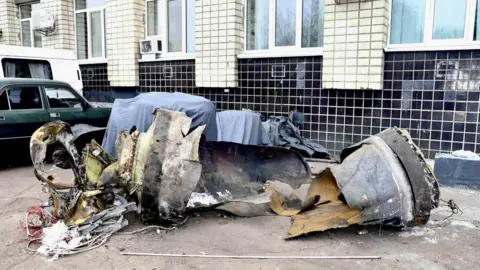
Conflict Armament ResearchAn unusual-looking wreckage that holds many clues
On 2 January, a young Ukrainian weapons inspector, Khrystyna Kimachuk, got word that an unusual-looking missile had crashed into a building in the city of Kharkiv. She began calling her contacts in the Ukrainian military, desperate to get her hands on it. Within a week, she had the mangled debris splayed out in front of her at a secure location in the capital Kyiv.
She began taking it apart and photographing every piece, including the screws and computer chips smaller than her fingernails. She could tell almost immediately this was not a Russian missile, but her challenge was to prove it.
Buried amidst the mess of metal and spouting wires, Ms Kimachuk spotted a tiny character from the Korean alphabet. Then she came across a more telling detail. The number 112 had been stamped onto parts of the shell. This corresponds to the year 2023 in the North Korean calendar. She realised she was looking at the first piece of hard evidence that North Korean weapons were being used to attack her country.
"We'd heard they had delivered some weapons to Russia, but I could see it, touch it, investigate it, in a way no-one had been able to do before. This was very exciting", she told me over the phone from Kyiv.
Since then, the Ukrainian military says dozens of North Korean missiles have been fired by Russia into its territory. They have killed at least 24 people and injured more than 70.
For all the recent talk of Kim Jong Un preparing to start a nuclear war, the more immediate threat is now North Korea's ability to fuel existing wars and feed global instability.
Ms Kimachuk works for Conflict Armament Research (CAR), an organisation that retrieves weapons used in war, to work out how they were made. But it wasn't until after she had finished photographing the wreckage of the missile and her team analysed its hundreds of components, that the most jaw-dropping revelation came.
It was bursting with the latest foreign technology. Most of the electronic parts had been manufactured in the US and Europe over the past few years. There was even a US computer chip made as recently as March 2023. This meant that North Korea had illicitly procured vital weapons components, snuck them into the country, assembled the missile, and shipped it to Russia in secret, where it had then been transported to the frontline and fired - all in a matter of months.
"This was the biggest surprise, that despite being under severe sanctions for almost two decades, North Korea is still managing to get its hands on all it needs to make its weapons, and with extraordinary speed," said Damien Spleeters, the deputy director at CAR.
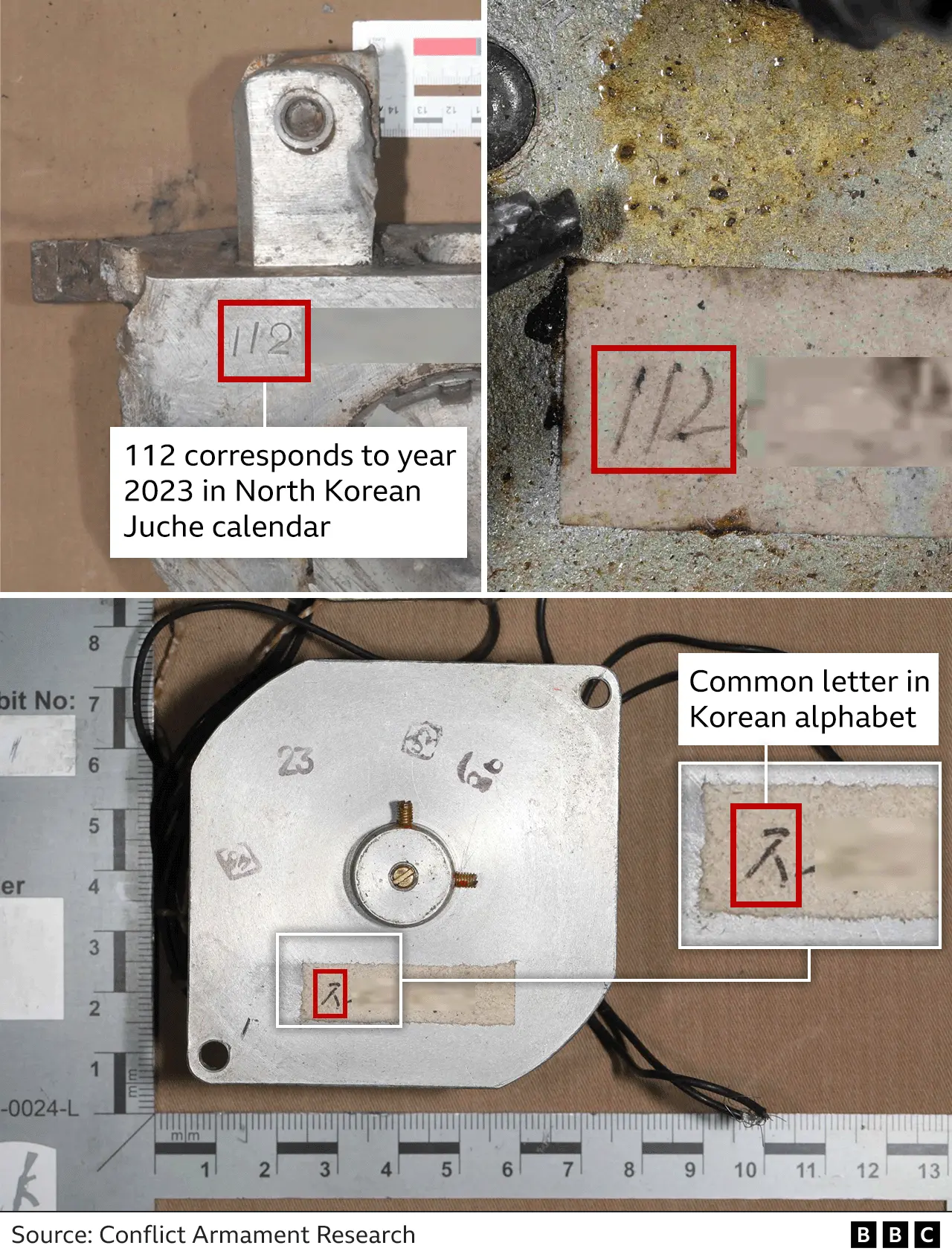
Over in London, Joseph Byrne, a North Korea expert at the defence think tank the Royal United Services Institute (RUSI), was equally stunned.
"I never thought I would see North Korean ballistic missiles being used to kill people on European soil," he said. He and his team at RUSI have been tracking the shipment of North Korean weapons to Russia ever since Mr Kim met his Russian counterpart Vladimir Putin in Russia in September of last year to strike a suspected arms deal.
Using satellite imagery, they have been able to observe four Russian cargo ships shuttling back and forth between North Korea and a Russian military port, loaded with hundreds of containers at a time.
In total RUSI estimates 7,000 containers have been sent, filled with more than a million ammunition shells and grad rockets - the sort that can be fired out of trucks in large volleys. Their assessments are backed up by intelligence from the US, UK and South Korea, though Russia and North Korea have denied the trade.

"These shells and rockets are some of the most sought-after things in the world today and are allowing Russia to keep pounding Ukrainian cities at a time when the US and Europe have been faltering over what weapons to contribute," Mr Byrne said.
Buying and firing
But it is the arrival of ballistic missiles on the battlefield that has concerned Mr Byrne and his colleagues the most, because of what they reveal about North Korea's weapons programme.
Since the 1980s North Korea has sold its weapons abroad, largely to countries in the North Africa and the Middle East, including Libya, Syria and Iran. They have tended to be old, Soviet-style missiles with a poor reputation. There is evidence that Hamas fighters likely used some of Pyongyang's old rocket-propelled grenades in their attack last 7 October.
Putin and Kim: Friends in need (of ammunition)What weapons are being supplied to Ukraine?What missiles has North Korea been testing?But the missile fired on 2 January, that Ms Kimachuk took apart, was seemingly Pyongyang's most sophisticated short-range missile - the Hwasong 11 - capable of travelling up to 700km (435 miles).
Although the Ukrainians have downplayed their accuracy, Dr Jeffrey Lewis, an expert in North Korean weapons and non-proliferation at the Middlebury Institute of International Studies, says they appear to be not much worse than the Russian missiles.
The advantage of these missiles is that they are extremely cheap, explained Dr Lewis. This means you can buy more and fire more, in the hope of overwhelming air defences, which is exactly what the Russians appear to be doing.
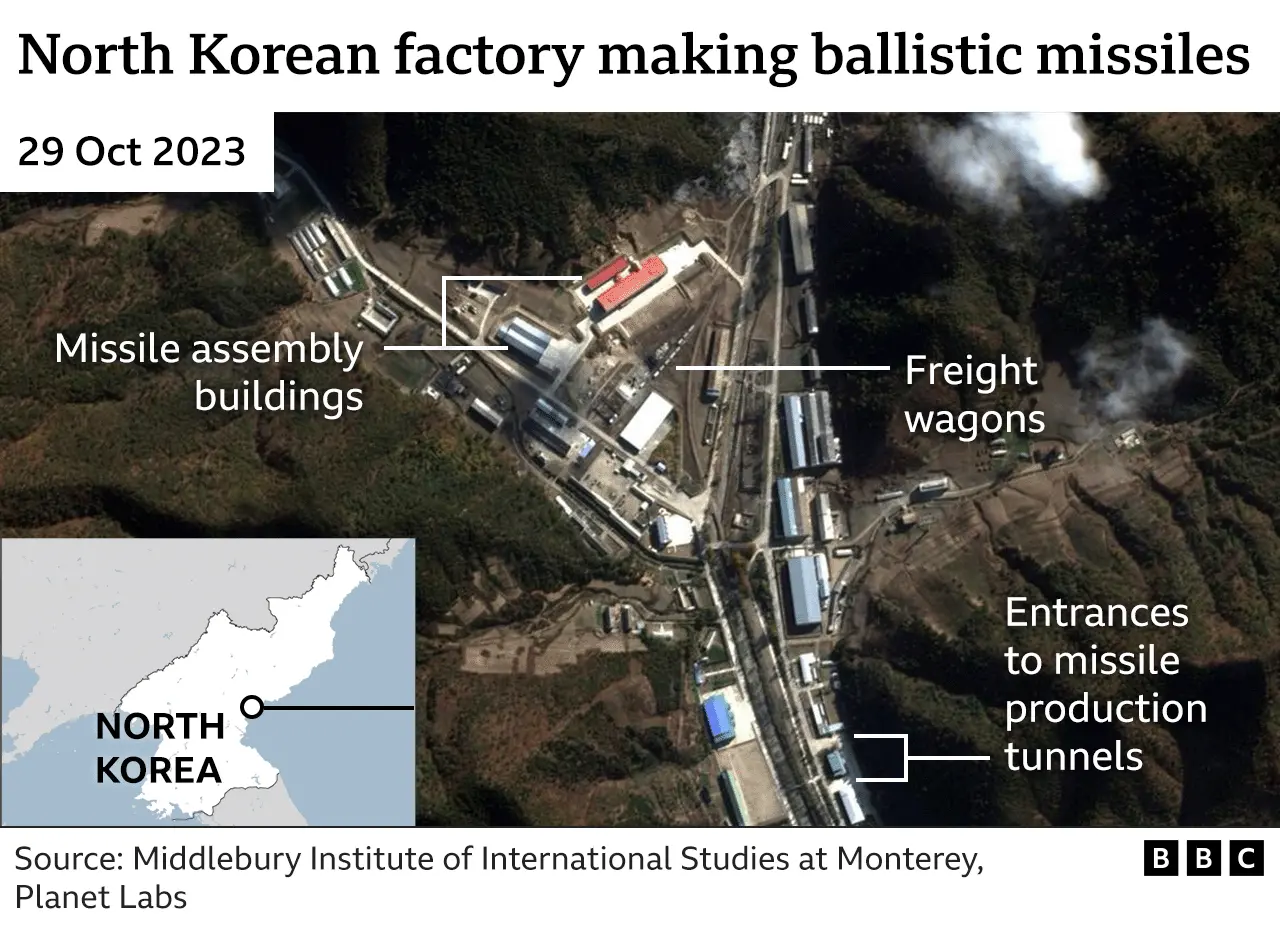
This then raises the question of how many of these missiles the North Koreans can produce. The South Korean government recently observed North Korea has sent 6,700 containers of munitions to Russia, it says that Pyongyang's weapons factories were operating at full-tilt, and Dr Lewis, who has been studying these factories through satellites, reckons they can churn out a few hundred a year.
Still reeling from their discovery, Mr Spleeters and his team are now trying to work out how this is possible, given that companies are banned from selling parts to North Korea.
Many of the computer chips that are integral to modern weapons, that guide them through the air to their intended targets, are the same chips that are used to power our phones, washing machines and cars, Mr Spleeters explained.
These are being sold all over the world in staggering numbers. Manufacturers sell to distributors in their billions, who sell them on in their millions, meaning they often have no idea where their products end up.
Even so, Mr Byrne was frustrated to learn how many components in the missile had come from the West. It proved that North Korea's procurement networks were more robust and effective than even he, who investigates these networks, had realised.
From his experience, North Koreans based overseas set up fake companies in Hong Kong or other central Asian countries to buy the items using predominantly stolen cash. They then send the products onto North Korea, usually over its border with China. If a fake company is discovered and sanctioned, another will quickly pop up in its place.
Sanctions have long been considered an imperfect tool to combat these networks, but to have any hope of working they need to be regularly updated and enforced. Both Russia and China have refused to impose new sanctions on North Korea since 2017.

By buying Pyongyang's weapons, Moscow is now violating the very sanctions it once voted for as a member of the UN Security Council. Then earlier this year it effectively disbanded a UN panel that monitored sanctions breaches, likely to avoid scrutiny.
"We are witnessing the real-time crumbling of UN sanctions against North Korea, which buys Pyongyang a lot of breathing space", Mr Byrne said.
All this has implications that reach far beyond the war in Ukraine.
"The real winners here are the North Koreans", said Mr Byrne. "They have helped the Russians in a significant way, and this has bought them a tonne of leverage".
In March, RUSI documented large amounts of oil being shipped from Russia to North Korea, while railcars filled with what are thought to be rice and flour have been spotted crossing the countries' land border. This deal, thought to be worth hundreds of millions of pounds, will boost not only Pyongyang's economy, but its military.
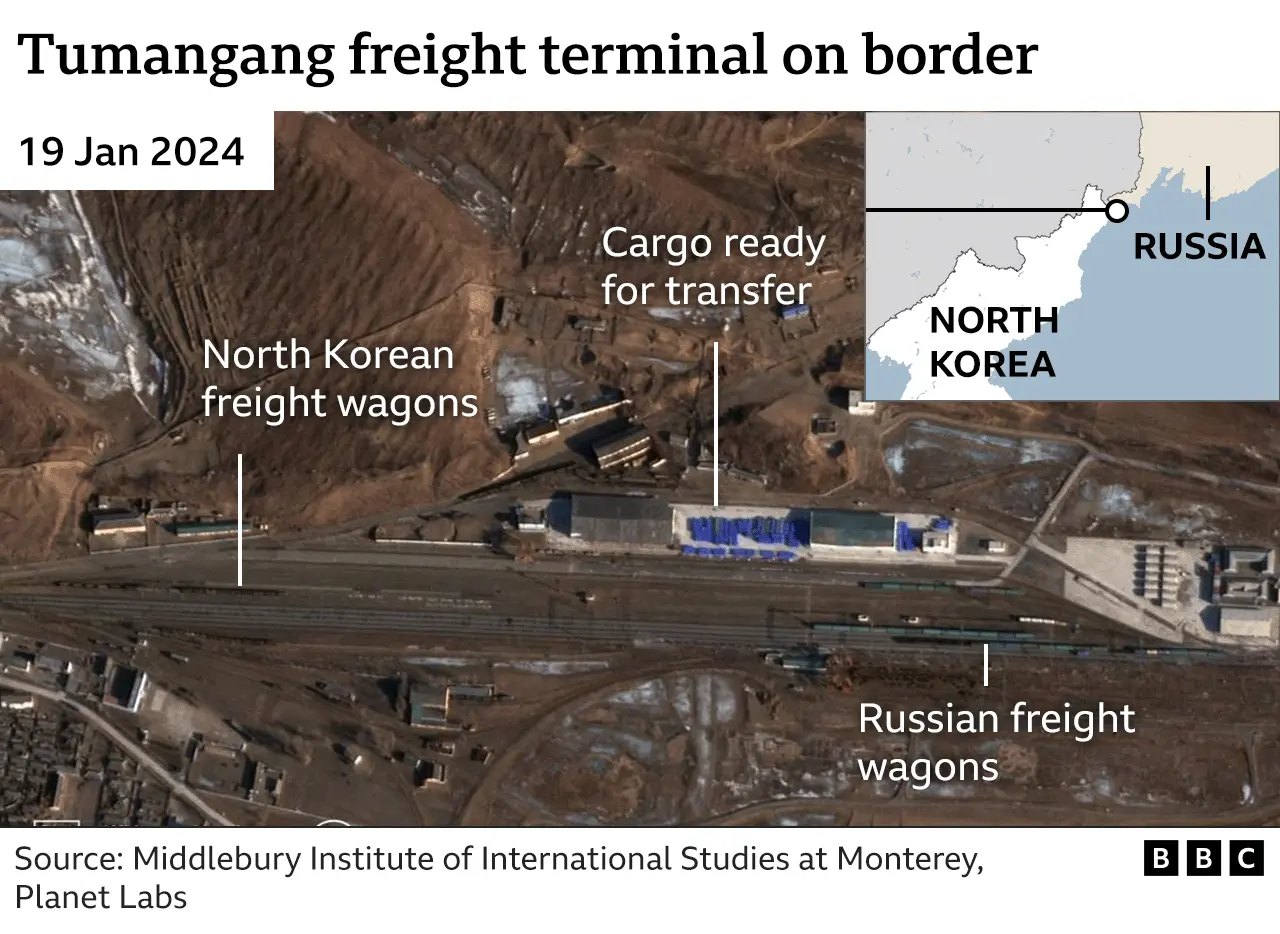
Russia could also supply the North with the raw materials to continue making its missiles, or even military equipment such a fighter jets, and - at the most extreme end - the technical assistance to improve its nuclear weapons.
Additionally, the North is getting the chance to test its latest missiles in a real-war scenario for the first time. With this valuable data, it will be able to make them better.
Pyongyang: A major missile supplier?
More troubling still is that the war is providing North Korea with a shop window to the rest of the world.
Now that Pyongyang is mass producing these weapons, it will want to sell them to more countries, and if the missiles are good enough for Russia, they will be good enough for others, said Dr Lewis - especially as the Russians are setting the example that it is okay to violate sanctions.
He predicts going forward that North Korea will become a big supplier of missiles to countries in the China-Russia-Iran bloc. In the wake of Iran's assault on Israel this month, the US said it was "incredibly concerned" that North Korea could be working with Iran on its nuclear and ballistic weapons programmes.
"I see a lot of gloomy faces when we talk about this problem," said Mr Spleeters. "But the good news is that now we know how reliant they are on foreign technology, we can do something about it".
Mr Spleeters is optimistic that by working with manufacturers they can cut off North Korea's supply chains. His team has already succeeded in identifying and shutting down an illicit network before it was able to complete a critical sale.
But Dr Lewis is not convinced.
"We can make it harder, more inconvenient, maybe raise the cost, but none of this is going to prevent North Korea from making these weapons," he said, adding that the West had ultimately failed in its attempt to contain the rogue state.
Now not only are its missiles a source of prestige and political power, but they are also generating it vast amounts of money, Dr Lewis explained. So why would Kim Jong Un ever give them up now?
What weapons are being supplied to Ukraine?
What $61bn US aid boost could mean for Ukraine
Russia said to be using N Korean missiles in Ukraine
What missiles has North Korea been testing?
Kim and Putin go public – but is it all a show?
Putin and Kim: Friends in need (of ammunition)
The hidden village just metres from North Korea
North Korea says it's got eyes on the White House - so what?War in UkraineAsiaNorth Korea

 이현승 씨 가족은 10년전 중국에서 탈북했다. 당시 이들은 도청을 피해 휴대폰 등 전자기기를 차 안에 두고 공원에서 탈북 계획을 세웠다. /RFA Rebel Pepper
이현승 씨 가족은 10년전 중국에서 탈북했다. 당시 이들은 도청을 피해 휴대폰 등 전자기기를 차 안에 두고 공원에서 탈북 계획을 세웠다. /RFA Rebel Pepper 수업에서 이현승 씨가 우크라이나 전쟁과 북미 관계에 대해 발표를 하고 있는 모습. 자신을 탈북 난민이라고 소개했다. /RFA Photo
수업에서 이현승 씨가 우크라이나 전쟁과 북미 관계에 대해 발표를 하고 있는 모습. 자신을 탈북 난민이라고 소개했다. /RFA Photo 컬럼비아 대학교의 한 강당에서 영화 ‘비욘드 유토피아’ 시사회가 열렸다. 해당 시사회는 탈북민 남매 중 동생 이서현씨가 한인 동호회와 함께 개최했다. /RFA Photo
컬럼비아 대학교의 한 강당에서 영화 ‘비욘드 유토피아’ 시사회가 열렸다. 해당 시사회는 탈북민 남매 중 동생 이서현씨가 한인 동호회와 함께 개최했다. /RFA Photo 자유의 여신상을 방문하기 위해 페리에 탄 이현승 씨의 모습. 현승 씨는 미국에 오기가 쉽지 않다고 자유아시아방송에 말했다. /RFA Photo
자유의 여신상을 방문하기 위해 페리에 탄 이현승 씨의 모습. 현승 씨는 미국에 오기가 쉽지 않다고 자유아시아방송에 말했다. /RFA Photo 워싱턴 포스트는 현승씨 가족을 북한의 상위 1%라고 소개했다. 이들은 고위 간부 리정호씨의 자녀로서 엘리트 교육을 받았다. /워싱턴 포스트
워싱턴 포스트는 현승씨 가족을 북한의 상위 1%라고 소개했다. 이들은 고위 간부 리정호씨의 자녀로서 엘리트 교육을 받았다. /워싱턴 포스트 교내 캠퍼스에 위치한 카페에서 과제를 하고 있는 이서현 씨의 모습. 과제와 시사회 준비로 바쁜 날들을 보낸 서현 씨는 전날 하루를 꼬박 앓았다. /RFA Photo
교내 캠퍼스에 위치한 카페에서 과제를 하고 있는 이서현 씨의 모습. 과제와 시사회 준비로 바쁜 날들을 보낸 서현 씨는 전날 하루를 꼬박 앓았다. /RFA Photo 이현승, 이서현 남매는 자본주의의 꽃으로 알려진 뉴욕 타임스퀘어를 방문했다. /RFA Photo
이현승, 이서현 남매는 자본주의의 꽃으로 알려진 뉴욕 타임스퀘어를 방문했다. /RFA Photo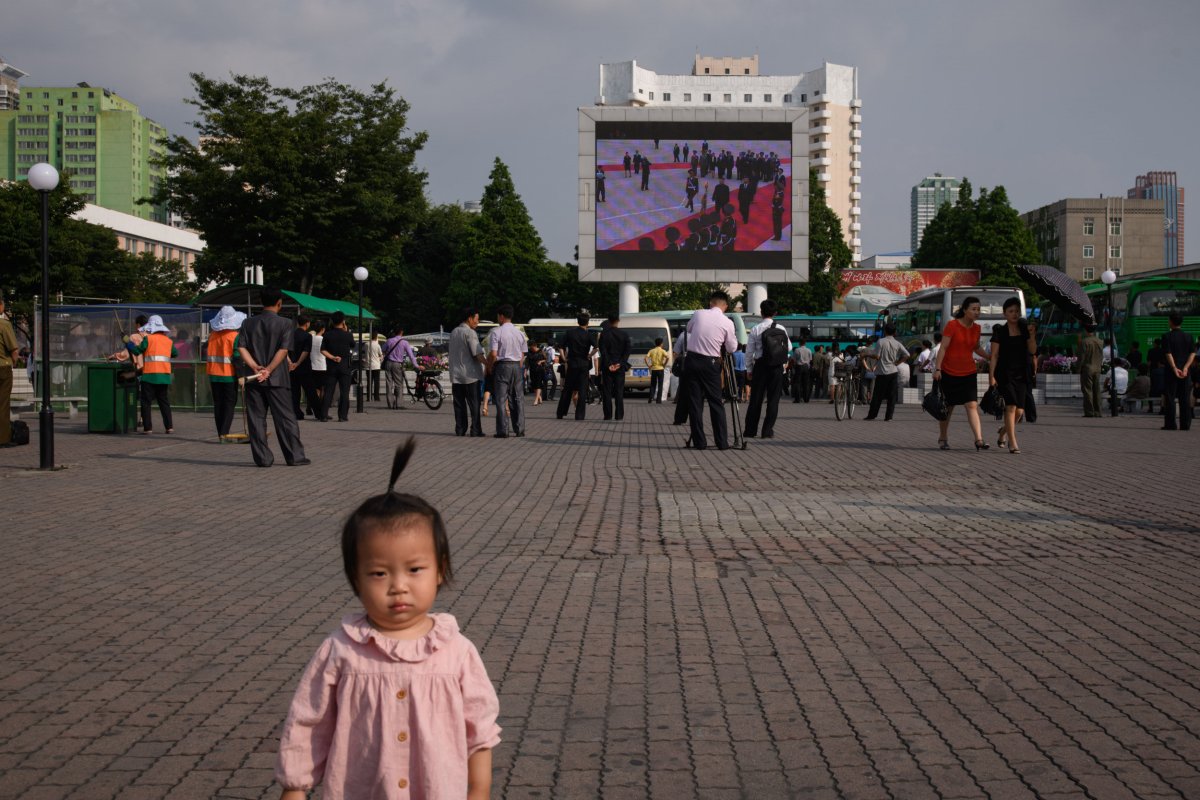
 President Donald Trump and North Korean supreme leader Kim Jong Un smile during a meeting at the second U.S.-North Korea summit at the Sofitel Legend Metropole hotel in Hanoi, February 28. Despite blaming one another's... More SAUL LOEB/AFP/GETTY IMAGES
President Donald Trump and North Korean supreme leader Kim Jong Un smile during a meeting at the second U.S.-North Korea summit at the Sofitel Legend Metropole hotel in Hanoi, February 28. Despite blaming one another's... More SAUL LOEB/AFP/GETTY IMAGES Conflict Armament ResearchAn unusual-looking wreckage that holds many clues
Conflict Armament ResearchAn unusual-looking wreckage that holds many clues



